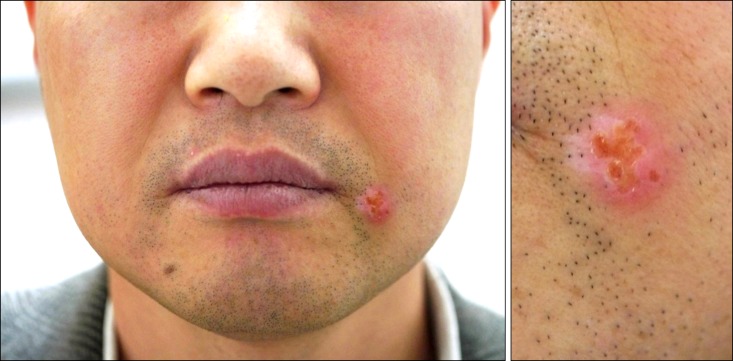Dear Editor:
Currently, 308-nm excimer laser (EL) therapy is considered the treatment of choice for localized vitiligo. It has recently showed a verified efficacy in treating a variety of hypopigmented dermatoses, such as pityriasis alba, chemical leukoderma, and nevus depigmentosus, as well1. Although the EL appears to be a promising treatment modality, its safety profile is not fully clear yet. The reactivation of herpes simplex virus (HSV) following EL treatment has been reported exclusively after ophthalmologic applications, which mostly use an EL (193 nm) for ablative procedures, such as keratectomy. However, no case has been reported in dermatology, where the EL is used for non-ablative photo-stimulating purposes. Herein, we report a case of HSV reactivation secondary to EL treatment in a patient with vitiligo.
A 48-year-old man presented with grouped vesicles on the left cheek for 4 days. Physical examination revealed a 1×1 cm2-sized, erythematous patch with grouped, crusted vesicles on a depigmented patch (Fig. 1). With a positive Tzanck test, the reactivation of HSV was diagnosed. He had a history of vitiligo on his left cheek and had been receiving EL treatment on the vitiliginous patch twice weekly for 7 months, starting with an initial dose of 150 mJ/cm2; the dose had been increased gradually to 350 mJ/cm2. His history included occasional relapses of herpes simplex labialis on his lips and no other underlying systemic diseases. After administering topical acyclovir ointment, the lesion improved markedly within a few days. As the typical skin lesion of HSV occurred exactly where the EL had been applied, it is assumed that the HSV reactivation was attributed to the EL treatment.
Fig. 1. Reactivation of herpes simplex virus on the vitiliginous lesion secondary to excimer laser treatment.
Latency and reactivation are unique biological features of herpesviruses. HSV is among the most widespread infections, affecting nearly 60% to 95% of human adults2. After primary infection, HSV ascend retrogradely through sensory nerves to the trigeminal, cervical, lumbosacral, or autonomic ganglia of the host nervous system. There, HSV is sequestered from the host immune surveillance, and persists in a dormant state for life. Once reactivated, HSV affects the innervated cutaneous sites through sensory neurons and leads to the formation of grouped vesicles2. Factors inducing the recurrence of latent HSV include ultraviolet light, immunosuppression, hyperthermia, trauma, emotional stress, hormone changes, and mechanical irritation3,4. Ultraviolet irradiation ranging from 280 to 315 nm is known to reactivate HSV in animal models and humans4. An EL emits 308-nm photoelectromagnetic waves; thus, this emission may contribute to reactivation of HSV. Physicians should be aware that EL irradiation may elicit the reactivation of HSV and we recommend surveillance in patients receiving EL treatment, especially in those with a history of HSV infection.
Footnotes
CONFLICTS OF INTEREST: The authors have nothing to disclose.
References
- 1.Beggs S, Short J, Rengifo-Pardo M, Ehrlich A. Applications of the excimer laser: a review. Dermatol Surg. 2015;41:1201–1211. doi: 10.1097/DSS.0000000000000485. [DOI] [PubMed] [Google Scholar]
- 2.Fatahzadeh M, Schwartz RA. Human herpes simplex virus infections: epidemiology, pathogenesis, symptomatology, diagnosis, and management. J Am Acad Dermatol. 2007;57:737–763. doi: 10.1016/j.jaad.2007.06.027. [DOI] [PubMed] [Google Scholar]
- 3.Deai T, Fukuda M, Tomoda Y, Higaki S, Hayashi K, Shimomura Y. Excimer laser photokeratectomy reactivates latent herpes simplex virus. Jpn J Ophthalmol. 2004;48:570–572. doi: 10.1007/s10384-004-0112-9. [DOI] [PubMed] [Google Scholar]
- 4.Asbell PA. Valacyclovir for the prevention of recurrent herpes simplex virus eye disease after excimer laser photokeratectomy. Trans Am Ophthalmol Soc. 2000;98:285–303. [PMC free article] [PubMed] [Google Scholar]



